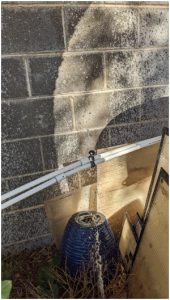By Emmy Ulmschneider
Master Gardener
We have all experienced the adage about learning from your mistakes and learning from gardening mistakes is no exception to this idea. This is especially true for us as our weather and growing conditions can change so radically from year to year and books or internet horticulture advice is not often tailored to our challenges. But we can all try various approaches and learn from the results. When you experience “failure” in your garden first use your observations to analyze what could have gone wrong. Look for relevant information on our website or try the Texas A&M Agrilife Extension website: tinyurl.com/bdhd33ee
So, here are two mistakes I have learned from recently:

I check my drip irrigation system for leaks in the spring and fall. Now I know to check it more often in squirrel season! Squirrels and drip irrigation do not go together. I do not know if they are after the water or as rodents, need to chew on hard objects to keep their teeth at the proper length, but the results are the same: loss of water during irrigation! And, that loss of water can be significant.
During our drought last summer, I was mending 10 to 15 leaks a day even though most of my drip is covered by mulch. Some of the damage was more than just a small bite mark. I noticed the problem by extensive wet areas in my chicken yard, the noise from erupting water geysers at night, and the significant increase in my monthly water bill!
A drip emitter emits about a quart of water an hour. I can only imagine how much water I wasted before I noticed the damage. Covering helps shield the drip from these pesky rodents. I have used mulch, compost, soil, fallen branches, or even unused tomato cages to keep squirrels away from the drip but the only way to catch all the leaks is to visually check often.
An invasive plant, whether native or non-native is invasive! My home landscape, outside of my food gardens, consists mostly of native plants. But native or not, a plant without associated natural controls like predators or geography can become a problem.
Having illustrated them, I am fascinated by ferns and fern allies. Consequently, I wanted to grow our native, Horsetail Rush, Equisetum arvense. This plant is often called scouring rush because its stem is coated in silica, once used to scour pots. I love its look in flower arrangements. First appearing in the Jurassic, they spread by spores and more quickly by rhizomes. Now, four years later, my equisetum has spread everywhere, and I cannot weed it out fast enough! If I ever do get it under control, I will confine it to a very large pot! So, check out the plants before you plant them. Here are three good references and next time, I will believe what I read!
Invasive Plant Atlas of the United States: invasiveplantatlas.org
Texas Invasive Database: tinyurl.com/bdzjz97x
Austin Invasive Plants: tinyurl.com/bdf8bawy
For more information, call the AgriLife office at 498-4071 in Odessa or at 686-4700 in Midland or visit aggie-horticulture.tamu.edu or westtexasgardening.org.




